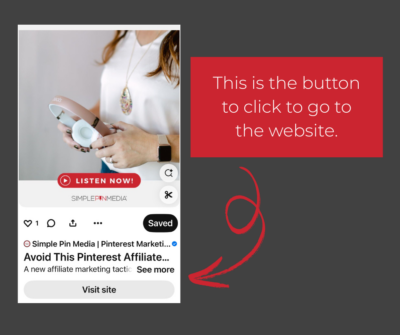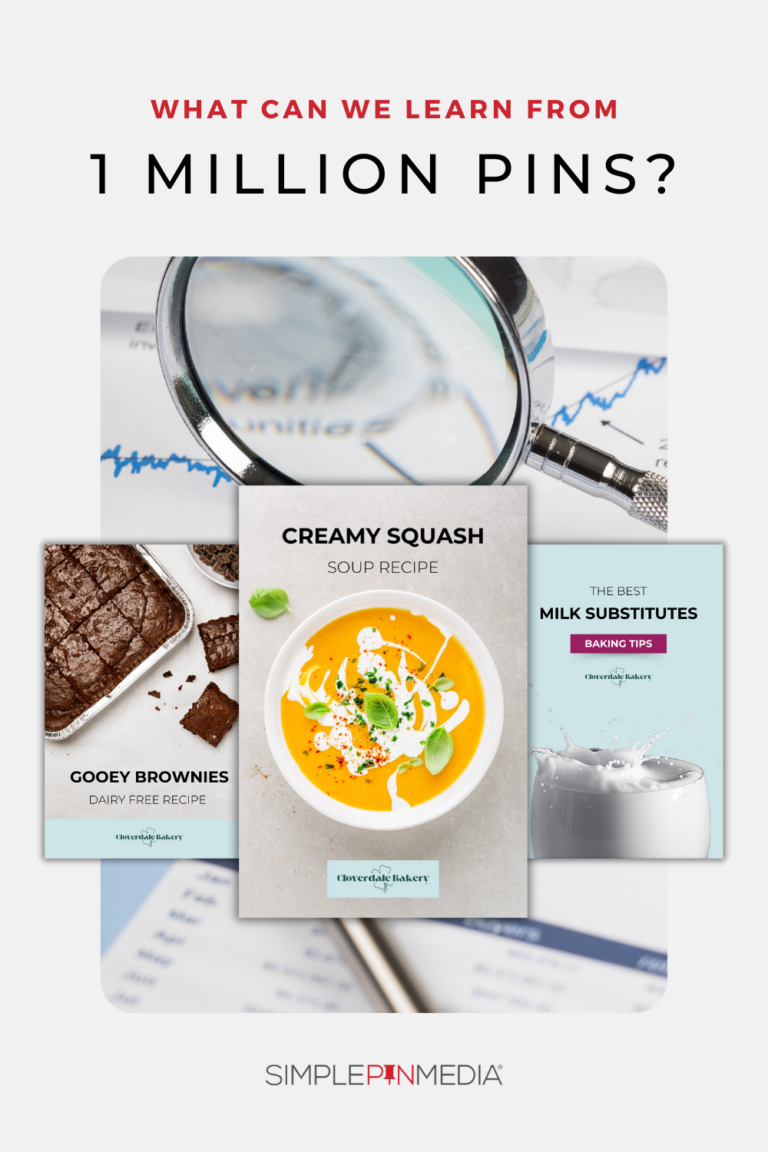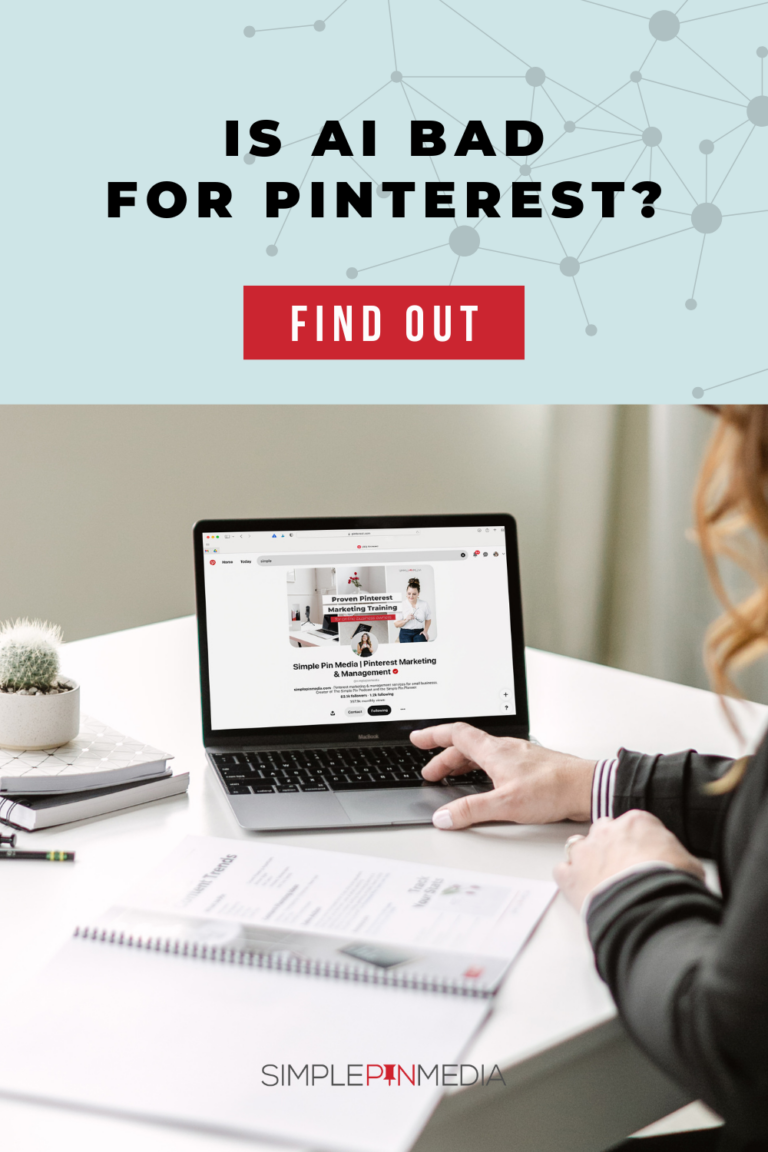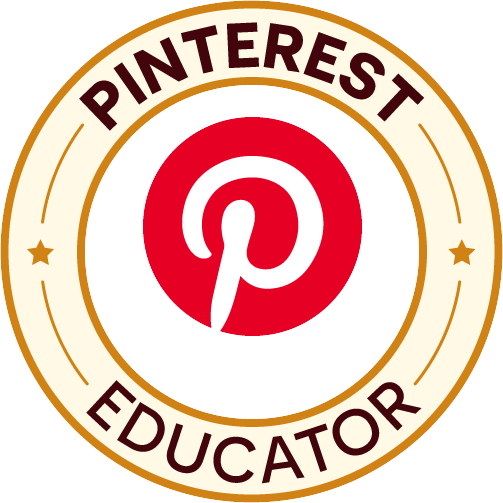Are you wondering what has happened to the “Visit Site” button on your Pinterest pins? You’re not alone. This feature that drives traffic to your website has moved for many Pinterest creators, potentially impacting your click-through rates and overall traffic.
As an official member of the Pinterest Educator Program, I have direct access to Pinterest’s team for answers to pressing questions like these. In this post, I’ll share Pinterest’s official explanation for why your “Visit Site” button might be missing and what you can do to fix this issue and restore this essential traffic-driving feature.
the “visit site” button on Pinterest
Pinterest has changed how users navigate from pins to websites. Previously, the experience worked like this:
- You’d see an image in your Pinterest feed
- When you clicked on the image for a closer look, it would open the pin
- From there, clicking on the image again would take you directly to the source website
Now, Pinterest has updated this process:
- You still click on an image in your feed to open the pin
- But when viewing the pin, the image itself is no longer clickable
- Instead, you need to find and click a specific “Visit Site” button located below the image
This seemingly small change can significantly impact how users interact with pins and potentially affect traffic to websites linked from Pinterest, as it adds an extra step to the user journey and makes the website link less prominent.
Everything you need to know about links on pins.
Before we dive in, rest assured links are not going away. Here’s what Malik Ducard (we recently recorded a podcast together) had to say on the matter:
Thanks for bringing this to my attention. Rest assured, links are here to stay, and the “visit site” button is not removed. For a very small percentage of Pins that link out to an inconsistent Pinner experience (e.g. Pins that don’t match the landing page they are linking to), the “visit site” button may be found in the “…” dropdown. – Malik Ducard, Chief Content Officier at Pinterest.

Recently, some users have noticed this button gone and the ability to click on the image also removed. Leaving people wondering, “how do you get to the website?”
I recently asked Pinterest about this change and why links are not displaying on pins:
“To help the user find information and ideas that they are looking for, we are making a change to the Pin’s closeup. We are highlighting a prominent “Visit site” button, when we see a strong match between the Pin and the landing page the Pin links out to.
When a Pin’s linked landing page is deemed to have lower quality, the “Visit site” button is less prominent on the Pin’s closeup page. Access to the link is moved to the overflow menu under the “…” dropdown. The link is not removed entirely but made less accessible. All other actions, such as save and comment continue to be prominently displayed to the user helping them to engage with the Pin more.“
I’m sure you had more questions like I did. What does “lower quality” mean? Or rather, how do you ensure your pins are high quality and not low quality.
A few recommendations from Pinterest: (I’ll give you my notes in italics.)
Enable website scraping: Allow Pinterest to understand where your Pins are linking – remove restrictions/limitations for Pinterestbot – steps outlined here.
- Here’s the easy to understand version.
- Pinterest has a tool called Pinterestbot that visits websites across the internet. This tool does two main things:
- It looks at public websites to add their content to Pinterest’s index, which helps send visitors back to those websites.
- It collects information from websites to keep Pin details (like prices and titles) up to date and removes Pins that link to broken websites.
- If you don’t want Pinterestbot visiting your website, or want to limit how much it visits, you can use a special file called “robots.txt” on your website to tell it to stop or limit its visits. <– YOU DO NOT WANT TO LIMIT THIS! We want Pinterest to crawl our site just like we want Google or AI tools to. Get found!
- Pinterest has a tool called Pinterestbot that visits websites across the internet. This tool does two main things:
Ensure a valid link: Avoid broken links, such as 404. Make sure you don’t have dead links or your re-directs are broken.
Match link to Pin:
- The landing page should show images and text that match the Pin.
- The Pin image should match with an image on the landing page. <– Interesting note here…I have more questions but in general this is a good marketing practice. Make sure people feel like they are in the right place by matching the images.
- Keywords in the Pin should match keywords on the landing page. Also pretty important for user experience.
- The landing page should provide additional content on the landing page. If you have a pin that links to a page with very little info, this isn’t going to serve you well. Common sense marketing.
Fast loading domain: Ensure your domain loads in under 4 seconds. I think this is pretty important for Google too. I don’t know about you but 4 seconds feels like an ETERNITY when you’re waiting for something to load. The Pinterest user will bounce real quick.
Maintain a safe domain:
- Follow product and merchant guidelines.
- Provide service information (e.g., contact form).
- Address suspicious reviews or inconsistent images.
- Avoid spam flags. Pinterest takes action on links that attempt to make money from Pinner web traffic in ways that are untrustworthy, detract from the users experience, or don’t add value for users.
- Avoid linking to websites with a large number of unsafe images.
- Upholding product requirements and merchant guidelines, if applicable.
What happens if your pin doesn’t have the “visit site” button and you’re following the rules?
Here’s what I asked the Pinterest team:
If a client or member from our community finds their pins following all of these guidelines but the “visit site” button is less prominent, is there a place they can go to refute the machine’s categorization of their pin?
Their response:
“If they do find and fix a link issue, our system will regularly re-evaluate link quality and add the “visit site” button prominently again when best practices are met.”
As far as an appeal process. There is not a formal appeals process for this, but if creators see impacted Pins that follow the link best practices, they can file a support ticket to raise the concern.
Takeaways
Your website matters. I can’t speculate on why Pinterest is moving to make these changes, but I’ve found that doesn’t serve any of us well. I do know they want to create a great experience for their users. That each pin they click on will be valuable, helpful, and that the pinner will find themselves in the right place.
A lot of the action items above are aligned with great marketing practices anyway — great images, great landing pages, fast site speed, and creating a great experience for readers.
What are your thoughts on this change?
More resources
📕 Pinterest Made Simple newsletter — every week on Wednesday with all the latest Pinterest news.
🎥 Simple Pin Media YouTube channel — lots of education updated weekly
🎙️ Simple Pin Podcast — over 3 million downloads and also updated weekly.





Thanks for explaining this! It’s been a painful experience since December as my Pinterest traffic was cut in half. Then the visit site button disappeared. But now I see it’s back! Hallelujah!! So, how can I check my website to see if a robots.txt file is in there?
I believe the link in the article can help walk you through this but my first and easiest one is that you have the visit site button on all pins.
So every time we make a new pin for an old post, we need to make sure that pin is inside the actual article????
I make new pins that are relevant to the post but I upload directly to Pinterest or from Canva. Will we be dinged if we continue this or do we manually have to put each pin we create inside the post???
I don’t believe it needs to be in the actual article. I think there is some nuance around this. I also don’t think you would be dinged. What I would suggest is watching your pins over the next month to get an idea of which pins have the visit site button and which do not. I have the visit site on all of my repins. I’m hopeful this measure will help us all by eliminating the bad actors who are pinning 100+ pins per day of low quality content. As with all changes, these things need to be sorted out.
Doesn’t it make it tricky to create fresh pins if now Pinterest is saying that the Pin image should match with an image on the landing page? I thought fresh pins with different images were rewarded even if they go to the same link? For example, it doesn’t make sense to add multiple images to a blog post just so you can create multiple pins for it that have matching images.
I think this is definitely a question that needs to be answered going forward. We’re framing up where we stand on this currently.
I’m wondering the same thing as others, about the pin image matching the landing page. Sometimes, for older landing pages where I have already created quite a few pins, I will use different images or stock images in an effort to create a pin that looks “fresh”. I’m curious how Pinterest views this.
Pinterest has said that if the pin image doesn’t closely match the landing page, the “Visit Site” button may be hidden.
If possible, try to match the image and keywords to what’s on the page. You can even create new pin designs for a URL that use the same image, the platform will still see that as new content.
Does making sure your website is claimed on Pinterest important? I ‘unlcaimed’ my website on Pinterest ~1 month ago because images were auto-pinning from my website without any design, text, etc and that’s exactly when I noticed my traffic cut in half, even though I still have ‘Visit Site’ on all of my pins…
Hi Lauren – yes, claiming your website is still really important. When unclaimed, Pinterest can’t fully connect your account to your content, which may impact your traffic and could possibly impact visibility of the “visit site” button.
If you’re still seeing a dip – I’d recommend reclaiming your site, and then to stop auto-publishing from an RSS feed, you can disable it in your Pinterest settings.